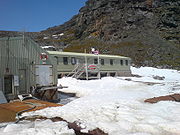
Signy Research Station
Encyclopedia

Signy Island
Signy Island is a small sub-antarctic island in the South Orkney Islands group locted at . It is about long and wide and rises to above sea level. Much of the island is permanently covered with ice. The average temperature range is to about in winter...
, run by the British Antarctic Survey
British Antarctic Survey
The British Antarctic Survey is the United Kingdom's national Antarctic operation and has an active role in Antarctic affairs. BAS is part of the Natural Environment Research Council and has over 400 staff. It operates five research stations, two ships and five aircraft in and around Antarctica....
.
History
Signy was first occupied in 1947 when a meteorological station was established in Factory Cove above the old whaling station. It was the second research base on the South Orkney IslandsSouth Orkney Islands
The South Orkney Islands are a group of islands in the Southern Ocean, about north-east of the tip of the Antarctic Peninsula. They have a total area of about ....
islands (after the Argentine
Argentina
Argentina , officially the Argentine Republic , is the second largest country in South America by land area, after Brazil. It is constituted as a federation of 23 provinces and an autonomous city, Buenos Aires...
Orcadas Base
Orcadas Base
Base Orcadas is an Argentine station in Antarctica, and the first permanent Antarctic station in the area defined by the Antarctic Treaty System. It is located on Laurie Island, one of the South Orkney Islands , at above sea level and from the coastline....
in 1903). In 1955, a new hut, Tønsberg House was built on the site of the whaling station. In 1963, it was turned into a laboratory for biological research. Initially operated year-round, since 1995/6 the station has been open from November to April each year (southern hemisphere summer).
Facilities
Today, the base has four buildings with capacity for 8 people. The main building, Sorlle House (named after the whaling captain who himself named Signy Island), provides living accommodation and laboratories. The other buildings are for storage and provision of power and water services. There are also four small huts around the island.Research
Marine and terrestrial biology is carried out at Signy, particularly looking at the effects of climate change on the southern ocean ecosystems. Three species of penguin (AdélieAdelie Penguin
The Adélie Penguin, Pygoscelis adeliae, is a species of penguin common along the entire Antarctic coast. They are among the most southerly distributed of all seabirds, as are the Emperor Penguin, the South Polar Skua, the Wilson's Storm Petrel, the Snow Petrel, and the Antarctic Petrel...
, Chinstrap
Chinstrap Penguin
The Chinstrap Penguin is a species of penguin which is found in the South Sandwich Islands, Antarctica, the South Orkneys, South Shetland, South Georgia, Bouvet Island and Balleny...
and Gentoo
Gentoo penguin
The Gentoo Penguin , Pygoscelis papua, is easily recognized by the wide white stripe extending like a bonnet across the top of its head and its bright orange-red bill. The gentoo penguin has pale whitish-pink webbed feet and a fairly long tail - the most prominent tail of all penguins. Chicks have...
) are monitored at the base.
To continue an original time series of visual sea ice observations after the station became summer-only, an automated sea ice camera now operates all year around, providing a continuous record of sea ice extent near the station for over 50 years.
External links
- Official website British Antarctic Survey
- BAS Signy Research Station
- BAS Signy Research Station Images at BASBritish Antarctic SurveyThe British Antarctic Survey is the United Kingdom's national Antarctic operation and has an active role in Antarctic affairs. BAS is part of the Natural Environment Research Council and has over 400 staff. It operates five research stations, two ships and five aircraft in and around Antarctica....
- COMNAP Antarctic Facilities
- COMNAP Antarctic Facilities Map

